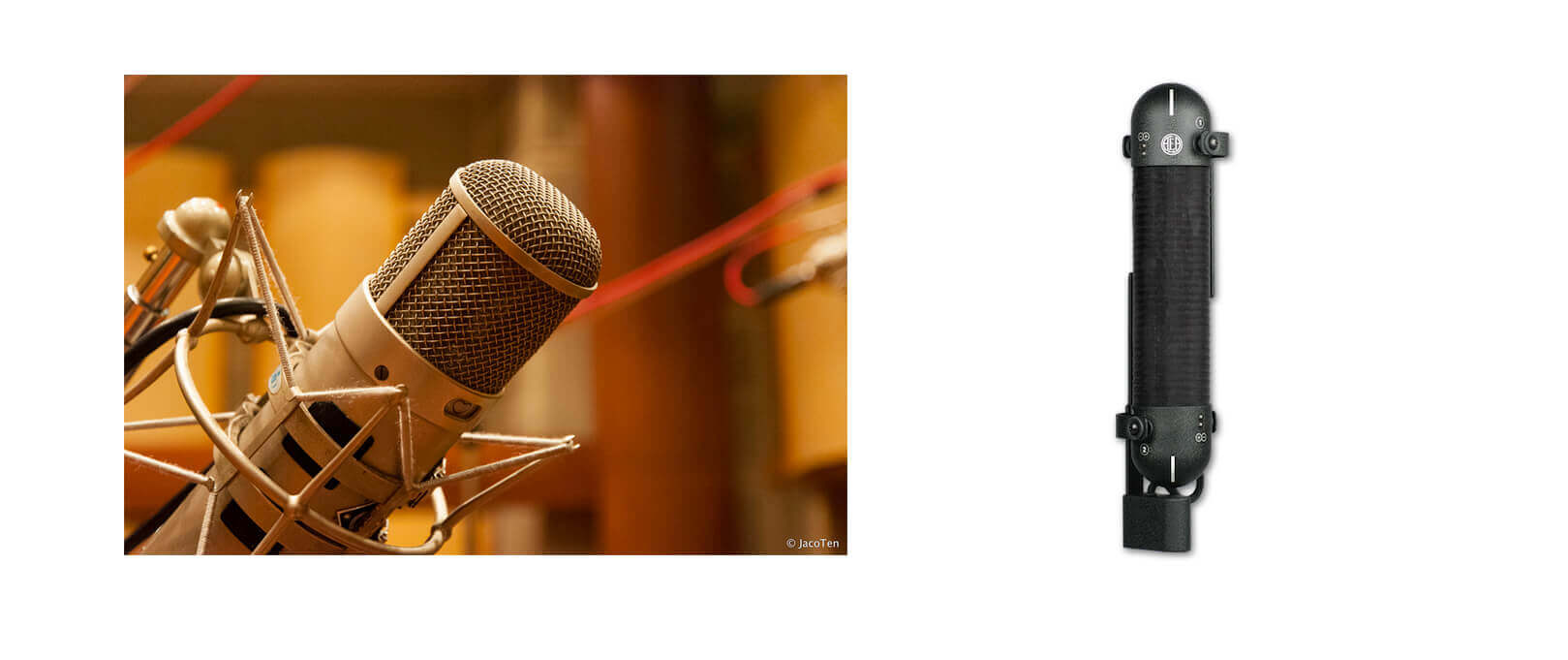In this excerpt from Episode 4 of “Greg Wells Start to Finish,” we begin with the artist, Bryce Drew, in the live room playing her acoustic guitar part from “Lucky Number. “Greg is in the control room, listening to the mics he chose for this application.
Experimenting
One of them is an AEA R88, which is a stereo ribbon mic. At first, he listens to that by itself, and then he asks the assistant engineer Zack to turn on the other one, a Neumann U47 tube mic, which is mono. Greg likes the combination of the two but thinks there may be a tiny phase issue between them.
Greg tells Zack to make sure that both mics are the same distance from the guitar. Zack goes into the studio and adjusts the positioning of the U47 a bit. When they listen again, Greg flips the phase button on the console for the U47, but it sounds thinner that way, so he flips it back.

The two mics Greg chose for Bryce’s acoustic guitar were a Neumann U47 (left) tube condenser and an AEA R88 (right), a stereo ribbon mic.
After listening some more and moving the fader for the U47’s channel to change the balance between the mics, both he and Zack agree that it doesn’t sound as good as it did at first. Greg asks Zack to put the U47 back to where it was.
Next, Greg adjusts the relative volume and tweaks the EQ a bit. He also checks his settings by turning the EQ off and on. He then listens with the U47 muted and unmuted, and does the same with the R88, before putting them both back.
After that, he’s satisfied and ready to move to the actual recording of the guitar part.
Opposites Cancel
When Greg flipped the phase (which is technically polarity, not phase), he was checking to see if the two tracks were out of polarity. That can happen when a component or cable in the signal chain is wired backward. That flips the waveform over completely, going from positive to negative so that its peaks lineup with the other track's troughs and vice versa.

The top and bottom tracks are 180-degrees out of polarity. You can tell because the waves are pointing in opposite directions, and the top and bottom look like mirror images. If you played these two tracks together in mono, they’d completely cancel each other out.
Being out of polarity can cause pretty severe phase cancellation when you listen to the tracks summed to mono. If the two signals are precisely 180 degrees out of polarity, they will cancel each other altogether.
1a: These two tracks were recorded on separate mics in a spaced-pair configuration. Due to a wiring issue somewhere in the signal chain, they ended up out of polarity with each other. They weren’t exactly 180-degrees out of polarity, so the sound didn’t get canceled entirely. However, the summed mono output of the two is quite thin due to a lot of phase cancellation.
1b. The same two tracks this time the polarity of the flipped track was reversed, putting it back to positive from negative.
It’s Just a Phase
When Greg asked Zack to reposition the mics, it was because he thought there might be a phase issue between the two, which is not the same as a polarity reversal. Phase issues occur when sound arrives at one of the microphones at a slightly different time than the other. It’s simply a matter of physics. All sound travels at the same speed, so if you’re recording with two (or more) mics and they’re not equidistant from the source, the sound waves will reach the mics at slightly different times and get recorded that way. (For more on phase vs. polarity, check out this Puremix article.)
When out of phase tracks are summed to mono, they may not sound as full and clean as when you listen to them in stereo or individually. Because one is playing back a tiny bit later than the other, it produces comb filtering (aka “phase distortion”), which can increase or decrease the amplitude at various frequencies, causing a dulling and thinning of the sound. Although the timing difference between the tracks is typically minuscule—measured in samples—it’s enough to degrade the audio.

These tracks are out of phase with each other. The arrow, pointing to the same peak in both tracks, shows the delay of the top track compared to the bottom one.
If you have comb filtering, flipping the phase switch isn’t going to solve the problem. To check for comb filtering, listen to both tracks together, in mono, and also look at their waveforms zoomed in to the sample level. Stack the two tracks on top of each other, zoom in pretty far, and look to see if the waves are lining up. If they’re not, and the tracks together sound thinner than they do individually, you can remedy the problem in a couple of ways.
One is to use a time-alignment plug-in such as Melda Productions MAutoAlign, which, after analyzing a section of one of the tracks, will automatically compensate on the other track so that they’re precisely aligned.

Melda Productions MAutoAlign is a time-alignment plug-in that makes it easy to align out-of-phase tracks.
Alternatively, you can manually slide one of the tracks to line it up with the other. You’ll have to zoom way in and nudge the later track to the left so that its peaks and troughs align with those of the earlier one.
Example 2a: In this example, the two mics used on this acoustic guitar track were in a spaced-pair configuration and not at the same distance from the guitar. As a result, one got recorded with a slight delay.
Example 2b: The out-of-phase track was manually slid to make it line up. Notice it sounds less phasey.
The same as Example 2b, but in stereo.